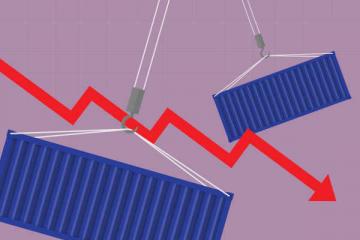Sorry, but your login has failed. Please recheck your login information and resubmit. If your subscription has expired, renew here.
November 2021
This is the last regular issue of Supply Chain Management Review for 2021. Normally this time of year, I look forward to what’s in front of us. That’s turned out to be a fool’s errand over the last year and a half. So, instead, I looked back to see what I wrote this time last year. My column was titled “COVID hasn’t stopped supply chain progress.” Browse this issue archive.Need Help? Contact customer service 847-559-7581 More options
The pandemic has upended virtually every supply chain process, from procurement to final-mile delivery, but perhaps none so much as planning and forecasting. I suspect managers now realize that when the COVID-19 virus started spreading and lockdowns were instituted, customer demand for all their products changed drastically. Conceptually, this rendered all products as newly introduced products, or mature products introduced into new markets. Historical demand was often useless, as demand varied during multiple phases in virus contraction and ensuing lockdowns. All product demands looked different, especially country to country.
What’s a demand planner to do? Muddle through the uncertainty.
In recent months, The Wall Street Journal has published two articles that illustrate the difficulties of forecasting during uncertainty. One detailed the plight of Driscoll’s, a distributor of strawberries, as well as producers of other perishable food products who have to provide a forecast to farmers in advance of the planting season. Fourteen months into the pandemic, Driscoll’s Mr. Soren Bjorn said that he “considers the models that once guided him inadequate for gauging how consumers or prices will behave once the pandemic subsides.”
Meanwhile, AB InBev, one of the world’s largest brewers, said that its data-scientist team had to pivot from making sales forecasts to focusing on “projecting where and when COVID-19 restrictions would ease or tighten around the world,” as well as tracking “hospital rates, mobility data, Google trends, and other [casual] data.” The brewer had resorted to using publicly available Australian data to help project EU sales, despite the fact that it did no business in Australia. Both WSJ articles inform managers on the types of data that might be used.

This complete article is available to subscribers only.
Log in now for full access or start your PLUS+ subscription for instant access.
SC
MR
Sorry, but your login has failed. Please recheck your login information and resubmit. If your subscription has expired, renew here.
November 2021
This is the last regular issue of Supply Chain Management Review for 2021. Normally this time of year, I look forward to what’s in front of us. That’s turned out to be a fool’s errand over the last year and a… Browse this issue archive. Access your online digital edition. Download a PDF file of the November 2021 issue.The pandemic has upended virtually every supply chain process, from procurement to final-mile delivery, but perhaps none so much as planning and forecasting. I suspect managers now realize that when the COVID-19 virus started spreading and lockdowns were instituted, customer demand for all their products changed drastically. Conceptually, this rendered all products as newly introduced products, or mature products introduced into new markets. Historical demand was often useless, as demand varied during multiple phases in virus contraction and ensuing lockdowns. All product demands looked different, especially country to country.
What’s a demand planner to do? Muddle through the uncertainty.
In recent months, The Wall Street Journal has published two articles that illustrate the difficulties of forecasting during uncertainty. One detailed the plight of Driscoll’s, a distributor of strawberries, as well as producers of other perishable food products who have to provide a forecast to farmers in advance of the planting season. Fourteen months into the pandemic, Driscoll’s Mr. Soren Bjorn said that he “considers the models that once guided him inadequate for gauging how consumers or prices will behave once the pandemic subsides.”
Meanwhile, AB InBev, one of the world’s largest brewers, said that its data-scientist team had to pivot from making sales forecasts to focusing on “projecting where and when COVID-19 restrictions would ease or tighten around the world,” as well as tracking “hospital rates, mobility data, Google trends, and other [casual] data.” The brewer had resorted to using publicly available Australian data to help project EU sales, despite the fact that it did no business in Australia. Both WSJ articles inform managers on the types of data that might be used.
 SUBSCRIBERS: Click here to download PDF of the full article.
SUBSCRIBERS: Click here to download PDF of the full article.
SC
MR


Latest Supply Chain News
- April manufacturing output slides after growing in March
- Q1 sees a solid finish with positive U.S.-bound import growth, notes S&P Global Market Intelligence
- World Trade Centers offers a helping hand to create resilient, interconnected supply chains
- 6 Questions With … Sandeep Bhide
- MIT CTL offering humanitarian logistics course
- More News
Latest Podcast

 Explore
Explore
Topics
Procurement & Sourcing News
- April manufacturing output slides after growing in March
- World Trade Centers offers a helping hand to create resilient, interconnected supply chains
- Bridging the ESG gap in supply chain management: From ambition to action
- Israel, Ukraine aid package to increase pressure on aerospace and defense supply chains
- How CPG brands can deliver on supplier diversity promises
- How S&OP provides the answer to in-demand products
- More Procurement & Sourcing
Latest Procurement & Sourcing Resources

Subscribe

Supply Chain Management Review delivers the best industry content.

Editors’ Picks





